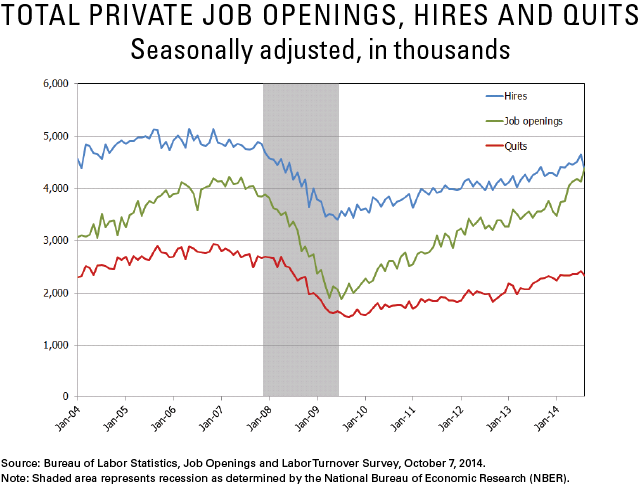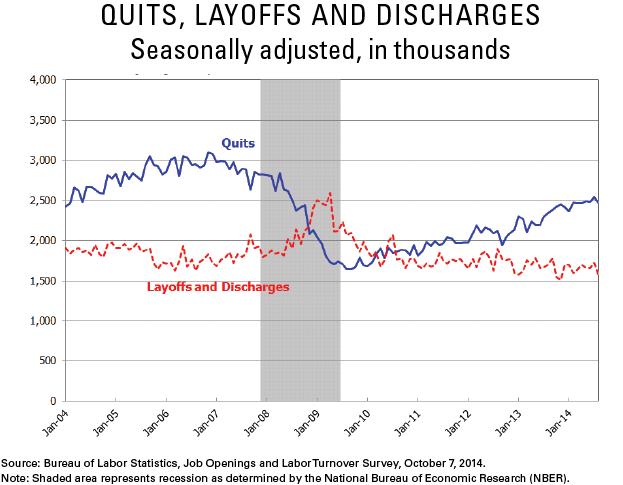Among several closely watched bellwethers of the incipient economic recovery, one indicator in recent months has quickened the pulse of pundits. The “quit rate” has inched up, setting off a round of optimism. “Workers Shed Caution in a Healthy Sign for Labor Market,” trumpeted a Wall Street Journal article earlier this year. “Millions Of People Are Quitting Their Jobs Every Month. That’s Good News,” reported NPR reassuringly.
The resurgent quit rate—the percentage of workers leaving jobs voluntarily—may indeed end up being cause for celebration, especially if other economic indicators rise with it. The willingness to quit signals a welcome movement in the job market because it loosens up opportunities and mobility, as well as hints at increased confidence of workers who may be leaving one job before finding another. But the news isn’t all good — nearly a decade of depressed job numbers leaves some experts wondering about what kind of damage has been wrought on career arcs, the psyche of the American worker, and employer-employee relations.
It’s been a long haul, after all. Back in 2006, the quit rate was holding steady around a healthy 2.5% for the private sector. By 2009, it had dipped to 1.4%, according to the U.S. Bureau of Labor Statistics (BLS), and by last year had only recovered to 1.8%. For a while, during the worst of the recession, workers were so fearful about the economy that the number of people quitting dipped below the number being laid off or fired — an inversion of the norm.
So when the private-industry quit rate rebounded to 2% in April, many cheered. But the Great Recession has been different from previous downturns. It has loosened ties between employers and employees and eroded loyalty on both sides.
“It used to be that job satisfaction would spike up in recession, but with this recession job satisfaction fell a lot, as did perceptions of commitment,” says management professor Peter Cappelli, director of Wharton’s Center for Human Resources. “I don’t think there were very many employers who even pretended to shield their employees from the downturn, so if you think about why employees would stay, it’s not because of loyalty — it’s fear that if you change jobs, something bad is going to happen to you. The fear right now is nobody wants to jump into an organization they think is still restructuring. This is a kind of devil-you-know problem.”
The direction of the quit rate by itself — which has remained flat since April — isn’t particularly meaningful, says Wharton management professor Matthew Bidwell, but combined with other metrics, it helps to indicate whether conditions are improving.
“What tends to drive mobility a lot of the time is when an existing firm grows, or new firms get started. And so where do they get workers from? They pull them out of other firms,” he says. “So when you see a higher quit rate, what you’re seeing is the process of pulling people out of jobs. And the fact that this is not happening is certainly a change in U.S. capitalism. There are different ways to organize the workforce and production, but in a country that always had this entrepreneurial model, this kind of shift looks like a lot less job creation. That alarms people.”
“I don’t think there were very many employers who even pretended to shield their employees from the downturn, so if you think about why employees would stay, it’s not because of loyalty…”–Peter Cappelli
An Employers’ Market
The other reason to worry is that while the quit rate appears to be recovering, factors apart from job creation itself may be distorting the rate to appear better than it actually is. The federal government has been tracking the quit rate since 2000, but Federal Reserve Board chair Janet Yellen raised the number to a seemingly higher level of significance in 2013 when she said that “a pick-up in the quit rate, which also remains at a low level, would signal that workers perceive that their chances to be rehired are good — in other words that labor demand has strengthened.” More recently, in August, she reiterated her credo: “I take the quit rate in many ways as a sign of the health of the economy.”
This week, the BLS announced in its Job Openings and Labor Turnover Survey that the August 2014 level held steady at 2% for private industry. But the quit rate has not yet recovered to 2006 levels, much less the peaks reached during the boom years. And at least some of the reason it has risen may take the wind out of the sails of optimists. Quit rates vary by sector, and much of the job growth in this recovery has been in lower-paying jobs like retail and food service, where turnover is generally higher anyway. Additionally, the introduction of the Affordable Care Act has likely emboldened some to work part-time or leave the work force altogether, which could result in a somewhat higher quit rate.
Bidwell points out that one of the benefits of moving from job to job in the past was the promise of more money. But wage growth has stalled. “It used to be you could start in a low-skill job, then move into a mid-skill job, but now it’s much harder to move into a higher-skill job,” he notes. “The decline of manufacturing didn’t help. There is a surprising amount of evidence that the growth of China as an exporter has had a more damaging effect on the labor market than anyone thought. All the trends point to widening inequality. The labor market is not in a happy place.”
For employers, on the other hand, a depressed quit rate has been beneficial, says Bidwell. “Hiring is expensive, turnover tends to be disruptive, and if workers don’t feel like they have many options, it strengthens employers’bargaining power,” he notes. “I think there tend to be a lot of people who think that with fresh blood you might get rid of the people you want to lose, but most studies have not found that. A low quit rate is good for employers. It does still look pretty much like an employers’ labor market.”
The average worker is feeling the lack of prospects. Even as unemployment rates have fallen this year, a May Pew Research Center/USA Today survey of 1,501 American adults found a disconnect between brightening statistics and conditions as workers are actually experiencing them. Only 27% of those surveyed said they believed jobs to be “plentiful.”
“It used to be you could start in a low-skill job, then move into a mid-skill job, but now it’s much harder to move into a higher-skill job.”–Matthew Bidwell
Looking at quit rates and other data, economics professors Steven J. Davis of the University of Chicago and John Haltiwanger of the University of Maryland have found that U.S. labor markets have become much less fluid —and that rates illustrating this point have been falling for decades, and cut across geographic, demographic and industry-sector lines.
The erosion, they argue in “Labor Market Fluidity and Economic Performance,” has been harmful to productivity, wages and employment. “If our assessment of how labor market fluidity affects employment is approximately correct, then the U.S. economy faced serious impediments to high employment rates well before the Great Recession,” they write. “Moreover, if our assessment is correct, the United States is unlikely to return to sustained high employment rates without restoring labor market fluidity.”
Bidwell sums up the point the country has reached this way: “We are in a recovery. It’s not a great recovery. It’s hard to know what’s going to make it a great recovery. I think a lot of it is pretty depressing.”
Biding Their Time
“I think people maybe feel stuck where they are, and almost out of necessity are staying in a job as opposed to taking the risk of moving to something else, since there isn’t much payoff for doing that,” says the Economic Policy Institute’s Valerie R. Wilson, director of the Program on Race, Ethnicity and the Economy. “There is still a lot of slack in the labor market overall … and so there is still a lot of downward pressure on wages, and the quit rate won’t have the potential for growth until there is an increase in wages.”
But for workers who feel stuck, now is exactly the time to be looking for a new job, according to Pamela Skillings, author of Escape from Corporate America: A Practical Guide to Creating the Career of Your Dreams and president of career consulting firm Skillful Communications.
“I think some people are in a situation where they are staying in an environment they are afraid of leaving, and people are saying ‘I should be grateful for what I have,’” she notes. “At the same time, people are working harder than ever because a lot of places are understaffed. Even if you are willing to take a risk with something new, finding the time to look for a new job while working crazy hours is very difficult.”
“People are working harder than ever because a lot of places are understaffed, so even if you are willing to take a risk with something new, finding that time to find an opportunity while working crazy hours is very difficult.”–Pamela Skillings
It’s easier said than done, Skillings admits, but it’s important to make the time to move on “if you say to yourself on a regular basis, ‘I wish I could quit, I hate this job.’ Then I think it’s important to take some time — your lunch hour or half hour — to take some steps toward assessing the situation in your industry and asking whether it is as bleak as some would have you believe. Are there opportunities out there?”
The sustained period of a depressed quit rate has shaken the confidence of some, says Skillings. “If you are going on an interview and come [across] as negative, it may sound corny but it’s all about practice…. It’s about writing a script and saying, ‘Here are what my message points are,’ like a politician or someone going on the Today show, so you can feel natural and convey what you want to convey.”
Some of Skillings’ clients are content in their jobs, but she also senses “a lot of frustration”on the part of workers unhappy with their jobs — and it’s an unhappiness that may be waiting for a chance to express itself. “I do think that people are, from what I’ve seen, biding their time,” she notes. “A lot of companies have taken the focus away from employee retention and making people feel challenged and other things that can make for a great place to work. Anything that is not essential, that is where the budget gets cut. That attitude takes a toll in people feeling that they are being taken exploited.”
How does someone know that it’s time to leave a job — despite the risks? “There is a piece of research about marriage that says when you get to the point in a relationship and you see contempt in the expression on the other person’s face, even if it’s in the early stage, it’s a predictor for divorce,” says Monica McGrath, Wharton’s vice dean for the Aresty Institute of Executive Education. “I would say that’s a pretty good standard — contempt, certainly high levels of stress, feeling incompetent in an organizational structure.”
She adds that many organizations aren’t putting a lot of effort into “acknowledging people who are doing a great job. If you need that and are not getting it, and you have this distrust of the organization, all that has a negative effect on your whole person. I don’t know how someone would get up in the morning and go to work.”
It’s important, McGrath notes, for deeply unhappy workers to not wait until they reach the slam-the-door-and-walk-out stage. “That happens to people; they leave before they manage to find another job or before they’ve figured out how to map a job strategy,” she says. Cappelli adds that it’s never a good idea to leave a job before landing another one. “The market shows distaste for unemployed people looking for jobs,” he notes.
McGrath does not sense a lot of pent-up frustration from workers that can be traced to this recession in particular. “I don’t see it. I was hearing it 10 years ago, I heard it 20 years ago. Some people just get to that edge and it’s time to move on,” she notes. “I don’t believe in asking the question, ‘Is it fun anymore?’ But you can ask, ‘Am I being satisfied intellectually, am I feeling challenged in some way, and am I learning?’And if the answer is yes and you don’t have contempt, it may not be time to quit.”





